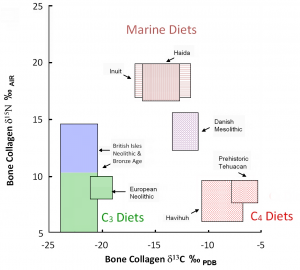Isotopic Analysis in Environmental Archaeology
The use of isotope analysis in environmental archaeology has expanded. By measuring the ratio of different isotopes found in human and animal remains, archaeologists may be able to tell a human or animal’s geological origin, including climate and seasonal movements, as well as their diet.
Most forms of isotopic analysis consist of analysis on bones and teeth and shells. An individual’s tooth is said to be able to provide a “geological snapshot from the early years of life, when teeth were developing.” An archaeologist could gain evidence of a person’s environment when they were younger as the isotopes in that environment during the period of time when the tooth was forming influences the isotopes found in that tooth. Another less used part of the body that can be analyzed is hair. It is thought to be not as susceptible to change due to age as bone and teeth may be and absorbs many isotopes from the surrounding environment.
The ecosystem a person lives in transfers isotopes to the people and animals feeding there. They are transferred when people eat animals and/or plants and by reading the different levels of different isotopes a pretty accurate construction of what their diet consisted of can be formed. For example vegans and vegetarians differ from those who are neither vegan nor vegetarian in the composition and levels of isotopes in their bodies. Isotope analysis sometimes shows cultural differences through dietary habits. Stable carbon and nitrogen values found in the bones from an Early Anglo-Saxon cemetery site provided results on how class distinctions altered dietary habits between the “wealthy,” “intermediate wealthy” and “poor.” It also showed how diets were not different between the sexes at the time. Another study in Europe, through isotopic research, was able to propose the idea that the Late European Mesolithic era diet consisted of mostly marine fish with small contributions from shellfish or marine mammals.

Dr. Thorton using strontium isotope analysis to investigate faunal resource exchange among the ancient Maya
Climate leaves is mark on human beings and animals alike with its own isotopic signature. A carbon ration may be used to show where an individual obtains his or her food, displaying if the food was from an arid environment or not. The isotope strontium can be used to discover an individual’s geologic origins. The prevalence of the isotope found in remains can indicate the area a person lived in according to the area’s own isotopic record. Oxygen isotopes provide a good climactic indicator as well as evidence to animal movements. If an individual lived at higher altitudes the air would have been thinner than someone living at or below sea level and they would have, consequentially, had a different oxygen isotope ratio.
Isotopic Analysis is growing in its significance and use in archaeology. It can be used to do more than just date remains or artifacts. It can create a picture of the object or artifact’s environment.
Sources:
http://rstb.royalsocietypublishing.org/content/354/1379/65.short
http://www.sciencedirect.com/science/article/pii/S030544030190785X
http://www.sciencedirect.com/science/article/pii/S0305440398903879
Additional Resources:
Biological Anthropology of the Human Skeleton, Second Edition
american archaeology: a quarterly publication of The Archaeological Conservancy

